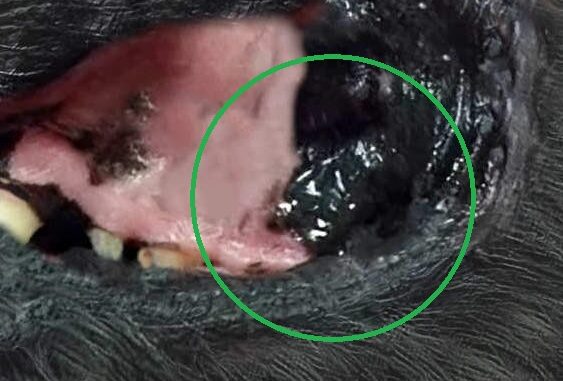
This article was updated on August 5th, 2023
Tumors in a dog’s mouth can often go unnoticed, with many of our canine friends reluctant to let us take a look! For some dogs, the first symptoms you notice may be increased drooling, traces of blood on toys or in their water, or even bad breath.
Unfortunately, most tumors in dogs’ mouths are malignant (cancerous) – but treatment is frequently an option. If you notice a lump or bump inside your dog’s mouth, it is vital to get a diagnosis as soon as possible so you can consider treatment options.
On this page, we will review pictures of the most common tumors that are found inside a dog’s mouth: from benign to malignant tumors (mouth cancer).
What is this lump or bump? Tumors often found in dogs’ mouths
1. Oral malignant melanoma
Unfortunately, the most common tumor found in dogs’ mouths is malignant melanoma. These cancerous growths usually occur on the gums but can also be seen elsewhere in the mouth and on the lips. They’re usually firm, relatively smooth and darkly pigmented (although up to a third don’t contain pigment). Affected dogs are usually older and it’s most common in dogs with dark, pigmented gums.
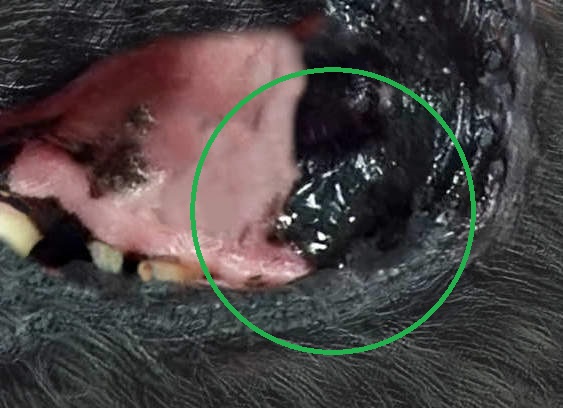
Over half of these tumors invade the nearby bone and they can spread to distant sites including the local lymph nodes and lungs. Treatment can include surgery, radiotherapy and chemotherapy; while the prognosis is guarded to poor, especially for larger tumors, mean survival times can reach over 1000 days if both surgery and chemotherapy are used. Learn more about diagnosis and treatment.
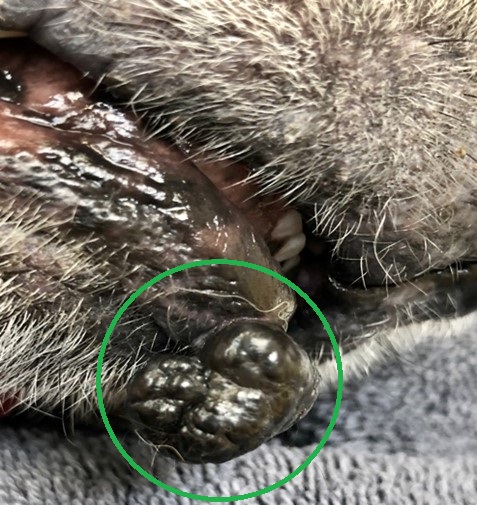
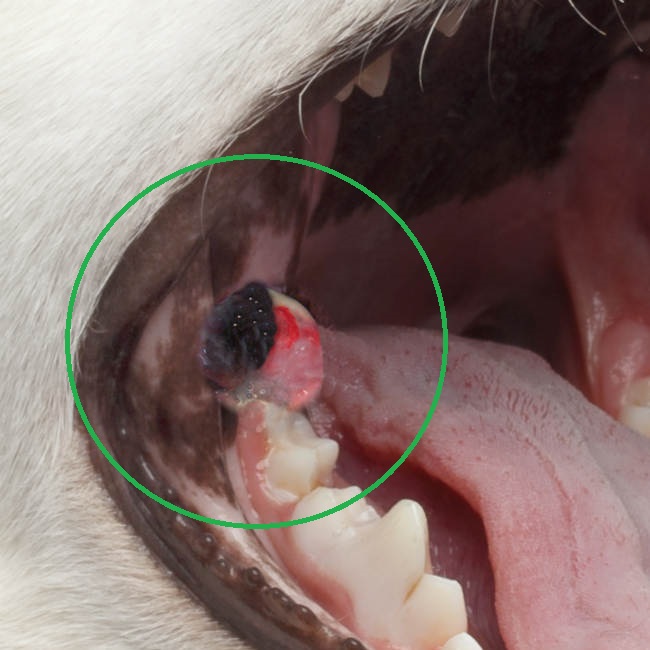
2. Squamous cell carcinoma (SCC)
This is the second most common type, accounting for between 17 and 25% of oral tumors in dogs. Again, it typically affects older dogs and mainly grows from the gums, but can be seen elsewhere in the mouth.The picture below shows a possible cancerous growth in the mouth that has ulcerated and is very inflamed:
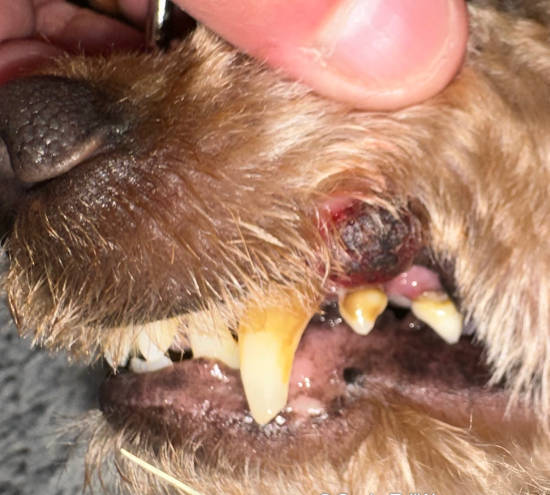
The appearance of SCC is very different, however, as it usually grows as an irregular, raised, cauliflower like mass that is frequently ulcerated; you may noticed irritation and bleeding, for example onto toys or into your dog’s water bowl.
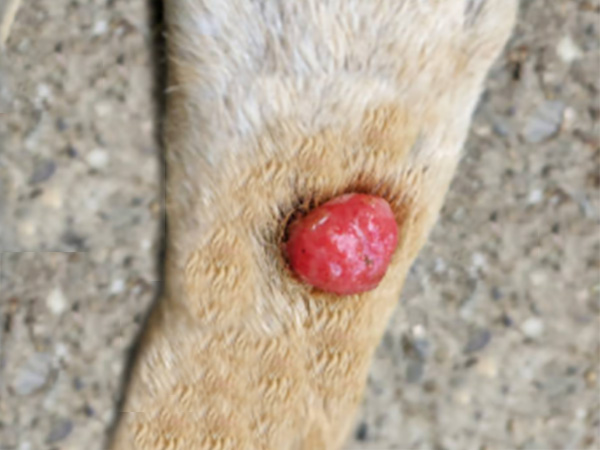
Around three quarters of these tumors invade nearby bone, so while metastasis (spread) to distant parts of the body is rare, treatment can still be challenging. It typically involves substantial surgery, sometimes with additional radiotherapy. The mean survival time for affected dogs after surgery is approximately 18 months, or 34 months if radiotherapy is also used. Generally, younger dogs and those with tumors nearer the front teeth have the best outcomes.
3. Oral fibrosarcoma
These fibrous, firm tumors are the third most common tumor in dogs’ mouths. They’re usually deeply attached, and like the previous tumors also invade into the bone, meaning local recurrence is unfortunately relatively common after surgery. Again, ulceration is common so you may notice traces of blood coming from your dog’s mouth.
Spread to the lymph nodes and lungs can occur in a minority of dogs but the biggest concern after surgery is local recurrence. Surgery for these tumors may require removal of part of the jaw, and unfortunately they don’t respond well to chemotherapy or radiotherapy. Mean survival time after surgery is 11 months.
Related post: Life Expectancy of Dogs with Mouth Cancer.
4. Epulides
Epulides (singular epulis) are the most common benign tumor in dogs’ mouths, and the fourth most common oral tumor overall. These benign growths develop next to teeth, from the tissues surrounding their roots, and can even seem to engulf teeth as they grow larger. If traumatised – by chewing, for example – they can occasionally bleed or cause pain. Treatment is usually surgical removal but can include cryosurgery or electrocautery; surgery can sometimes be combined with a more general dental procedure. These growths can recur locally but the overall prognosis is excellent.
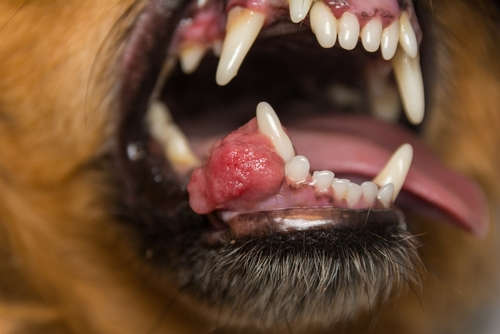
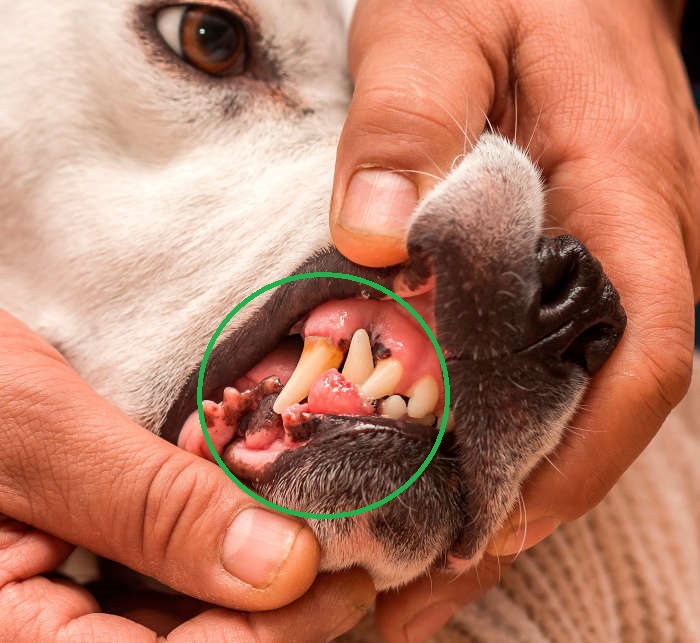
5. Oral osteosarcoma
This is the fifth most common oral tumor and – although malignant – the prognosis is usually better than for osteosarcoma elsewhere. Treatment is usually surgical, which requires part of the jaw to be removed. If it affects the lower jaw, mean survival time can be over a year after surgery.
6. Papillomas (warts)
Whilst not typically described as oral tumors, virus induced warts are a common finding in young dogs and frequently occur around the mouth, sometimes growing from the lips or even gums.
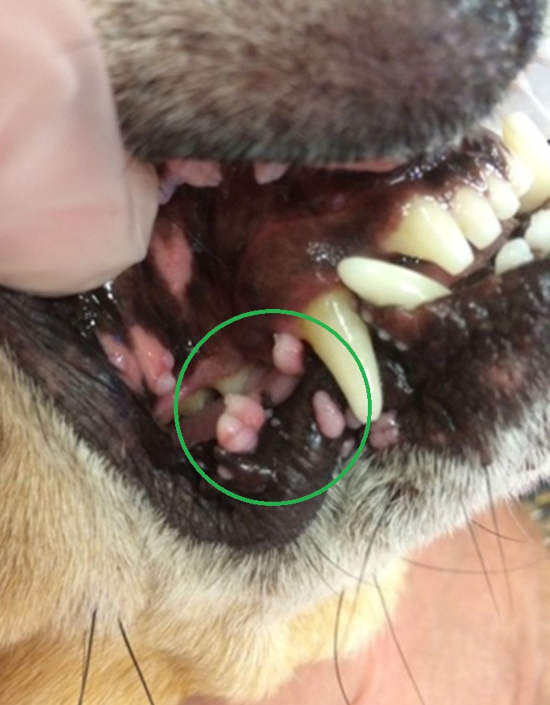
Warts have a characteristic irregular, cauliflower-like appearance and don’t typically cause inflammation (unless they’re traumatized by the teeth) or grow particularly large. They usually resolve over weeks to months – but if you’re concerned it’s worth getting them checked by a vet.
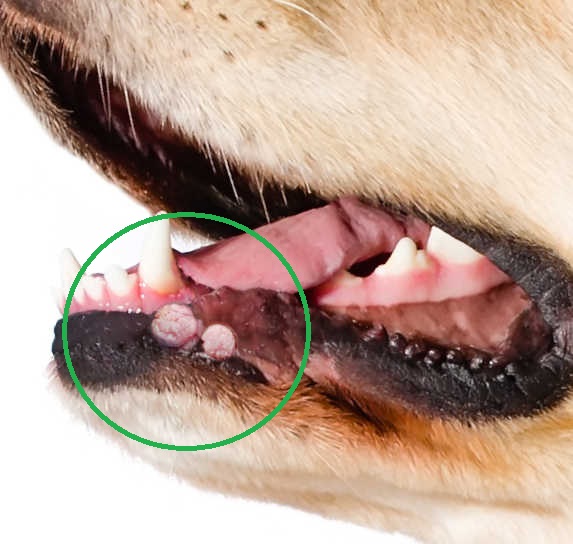
What to do if you find a tumor in your dog’s mouth
If you find a tumor in your dog’s mouth, the most important thing is to book an appointment with your vet as soon as you can to discuss the likely diagnosis and possible diagnostic tests. It’s best to avoid traumatising any lump – so avoid things like toothbrushing in this area. If your dog will tolerate it, you can try to bathe any irritated lumps with dilute salt water to help dislodge any food debris and keep them clean.
If your dog is struggling with chewing or you’ve noticed blood, it may also be best to avoid chew toys and consider feeding wet food (or adding water to their kibble).
However, the main thing is to get a diagnosis as quickly as possible.
Veterinarian diagnosis
Occasionally, vets can provide a likely diagnosis based on the appearance of the lump – malignant melanoma, for example, is often characteristically pigmented, while warts can also often be recognised. However, other lumps are likely to require further tests – and even if a diagnosis of malignant melanoma can be made, confirming this and getting a pathologist’s opinion on how aggressive the tumor is can still be helpful.
Due to the location, fine needle aspirates – which we often use for other tumors – can be hard to take, especially conscious. Your vet may recommend sedation or anaesthetic for a larger biopsy to be taken, enabling more thorough assessment under the microscope. They may also recommend x-rays to assess any local bone involvement or any spread to the lungs, and in some cases fine needle aspirate samples from local lymph nodes to look for cells that have spread.
Depending on the samples taken and tests performed, these tests can cost several hundred dollars, so it’s worth discussing with your vet beforehand.
With treatment, the prognosis for oral tumors can be reasonably good – but early diagnosis and treatment is essential. If you have any concerns about a lump in your dog’s mouth, this is one time you shouldn’t delay a vet visit.
References
Oral tumors. Veterinary Society of Surgical Oncology. https://vsso.org/oral-tumors
Epulis tumor in dogs’ mouths. Veterinary Partner. https://veterinarypartner.vin.com/doc/?id=6017279&pid=19239
Disclaimer: This website's content is not a substitute for veterinary care. Always consult with your veterinarian for healthcare decisions. Read More.


Be the first to comment